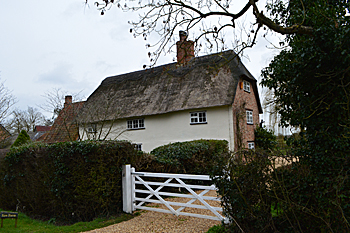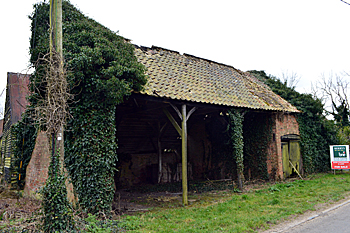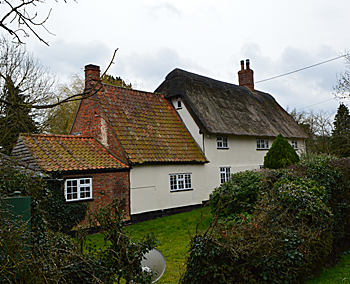Row Farm Keysoe

Row Farm from the south-west March 2016
Row Farmhouse was listed by the former Department of Environment in August 1983 as Grade II, of special interest. It dates from the 17th century and is built from colour-washed roughcast over a timber frame, with a brick faced south-west gable end and a thatched roof. It comprises two storeys and attics and has later additions to the north-east gable end, of one storey and attics and one storey, these are both colour-washed with pantiled roofs.
A terrier of about 1800 shows the farm in the ownership of the Crawley family of Stockwood Park, Luton. They were lords of the manor both of Keysoe Bury and Keysoe Grange, suggesting that the farm had always belonged to one of those manors. The tenant, William Ward, paid rent of £202 per annum for 240 acres [C1697]. An estate survey of 1830 shows the farm in occupation of a Mr Britton [WG2481], by 1849 the tenant was John Hawkins. In 1892 the tenancy changed from John Saunderson to William Henry Wilson [Z740/73/2] and in 1907 the executors of John George handled the winding up of that tenancy [WG2532].

Barn at Row Farm March 2016
In 1912 the Francis Crawley decided to sell their estates in Keysoe and Thurleigh. The sale particulars [X65/74] described the “comfortable” farmhouse as containing six bedrooms, a lumber room, a sitting room, a parlour, a kitchen, scullery and dairy. Adjoining the house as stabling for two horses and a coach house. The “good farm buildings” were built of brick and timber with tiled, thatched or slate roofs and arranged round a horse and bullock yard; they comprised: a cow shed for seven with a calf place; two pigsties; wood barn and hen roost; colt place; stabling for eight with gear and chaff place; shelter hovel; grenary; tool house; wagon shed and cart hovel. The land comprised 129 acres, 30 poles and the farm was in occupation of Thomas Stanton who paid £96 per annum for the farm and a separate pasture of 5.998 acresnearby.
The Rating and Valuation Act 1925 specified that every building and piece of land in the country was to be assessed to determine its rateable value. The valuer visiting Row Farm [DV1/H22/66] found that the owner-occupier was now Frank Sanderson, who had presumably bought it in 1912. Rents for the 135 acre farm had previously been £90 per annum, set in 1912 and £101 per annum, set in 1918. A colleague of the valuer commented: “Not bad farm. Take no notice of rent – low. Decent house and homestead”.
The farmhouse contained two reception rooms, a kitchen, a scullery and a dairy with four bedrooms and an attic upstairs. An earth closet stood outside. The homestead, wood on brick foundations with tiled and thatched roofs, comprised: a loose box; a garage; a corn barn; a two-bay open hovel; a chaff and hay barn; a four-bay open shed; a stable for six horses; another loose box; two hen houses; two pig boxes; a cow place for six beasts and a calf pen; a nag stable; one box and two standings and a coachhouse. On the road were: a three-bay cart hovel and an implement house. Soft water came from a pump and hard water from a pond.

Row Farm from the north-east March 2016